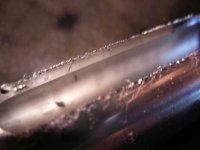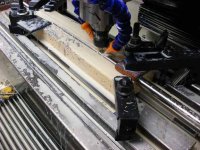pak
Cast Iron
- Joined
- Oct 31, 2007
- Location
- Miami Fl, USA
I am in the middle of a project that you all helped me with a while back. Here is the thread. http://www.practicalmachinist.com/vb/showthread.php/ot-fuel-level-round-184875.html
I am using a sight tube as some suggested. The sight glass will be protected with a ¾” stainless tube about 26 inches long. I need to cut slots in the SS tubing in order to see fuel level. See attached pictures.
Using my CNC mill, I tested a couple of bits that I had on hand. I used a range of feeds and speeds and the results were the same - less than desirable. Although they both cut fine, they left burrs on the top that will have to be removed by hand.
Is there a type of bit that I should be using that would not leave burrs on top? In wood working there is something called a down-cut bit where it leaves the surface very clean? I presume that there is something like this in the metal working field as well.
My question is; what is the best bit to use to leave a clean surface on the tubing? If I knew this, I could then experiment with the proper feeds and speeds.
Regards,
Drew
I am using a sight tube as some suggested. The sight glass will be protected with a ¾” stainless tube about 26 inches long. I need to cut slots in the SS tubing in order to see fuel level. See attached pictures.
Using my CNC mill, I tested a couple of bits that I had on hand. I used a range of feeds and speeds and the results were the same - less than desirable. Although they both cut fine, they left burrs on the top that will have to be removed by hand.
Is there a type of bit that I should be using that would not leave burrs on top? In wood working there is something called a down-cut bit where it leaves the surface very clean? I presume that there is something like this in the metal working field as well.
My question is; what is the best bit to use to leave a clean surface on the tubing? If I knew this, I could then experiment with the proper feeds and speeds.
Regards,
Drew
Attachments
Last edited:




